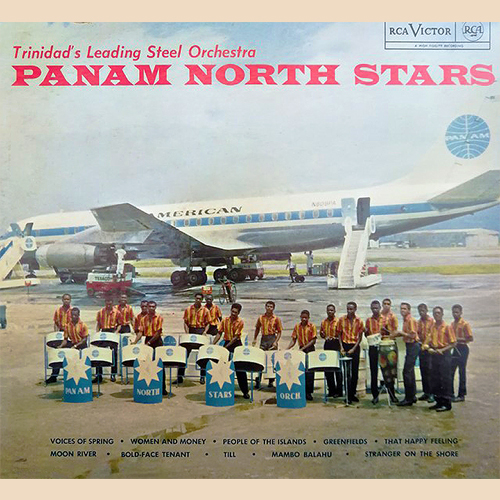WINGS SPREAD FAR AND WIDE
The Pan Am North Stars Steel Band: A Connection of Note
The story of Tony Williams, master of steel pan music, and the top Steel Band in the Caribbean, who combined forces with Pan American World Airways in the 1960s to create the lively and popular Pan Am Jet North Stars.
When Pan Am, the airline, left the scene in 1991, it left a great void in the world of air travel. But like so many great enterprises the lasting human imprint is much harder to ignore. Pan Am, the corporation and its subsidiary entities employed tens of thousands of men and women over the decades, and lofted many millions of passengers around the globe. Those things are quantifiable, and countless stories are still shared about working and traveling on the “world’s most experienced airline.” It may be that Pan American was the world’s most influential airline too.
For many, Pan Am meant something more than a means of transportation or a career. The Pan Am Jets wheelchair basketball team, for example, connected the airline in ways that meant much more than air travel. (See “The Man Who Saved Basketball”, the story of Junius A. Kellogg and the Pan Am Jets. https://www.panam.org/pan-am-inspirations/696-pan-am-jets).
Another example: Pan American’s Technical Assistance Programs, which sought to foster modern aviation technology and practice in countries such as Afghanistan and Pakistan. That time is fading now, but the knowledge and mentoring shared by Pan Am personnel in developing nations engendered a legacy of good will and friendship that the world could use more of now.
And then there was the lively Pan Am North Stars Steel Band. In Trinidad and Tobago, the land of the “pan.” Trinidad is a nation where local music and the traditions that support that culture have great importance. A little history can help explain.
TRADITION MEETS INNOVATION
In Trinidad, the cultural heritage of descendants of enslaved forebears was sharply restricted by an anxious and watchful ruling colonial British regime. Although slavery was made illegal in 1834 (though human bondage stayed in place for four more years) traditional religious expression and cultural practices based on African culture such as using drums were legally suppressed. Even gatherings where such traditions might be practiced were restricted. The long-established holidays of Carnival, just before Ash Wednesday, and Camboulay, commemorating Emancipation Day (August 1), were carefully corralled by Trinidad’s colonial rulers. When World War II engulfed the British Empire in 1939, ALL public celebrations were banned. But Trinidad’s musicians were nothing if not resourceful. They continued to find means of expression that suited their musical inspiration. In the 1930s, it was found that discarded biscuit tins and caustic soda bottles could make reasonable percussive instruments with a little improvisation. But the evolutionary process really took hold with availability of a cornucopia of oil and fuel drums that came with war. The steel drum, the cut down bottom of an oil drum, or the “pan,” became an instrument of choice. The pans could be fashioned to produce a variety of notes and timbres, with varying numbers of notes on each. Making and playing “pan” became an indigenous national art form.
And with the return of peace, the lid came off social restrictions, and the pans came out. The world had changed. The old ways of Empire and colonial rule were fast receding. And resurgent tourism was bringing new audiences to Trinidad and Tobago (A great many on Pan American World Airways aircraft, of course), who could and would pay to hear some exciting new sounds that would provide an inspiring soundtrack to the memories they would take back home.
In 1950, Trinidad’s steel band movement really came of age. The Trinidad All Steel Percussion Orchestra (TASPO) was formed by the Trinidad and Tobago Steelband Association, specifically to take part in the Festival of Britain being held in 1951 in London.
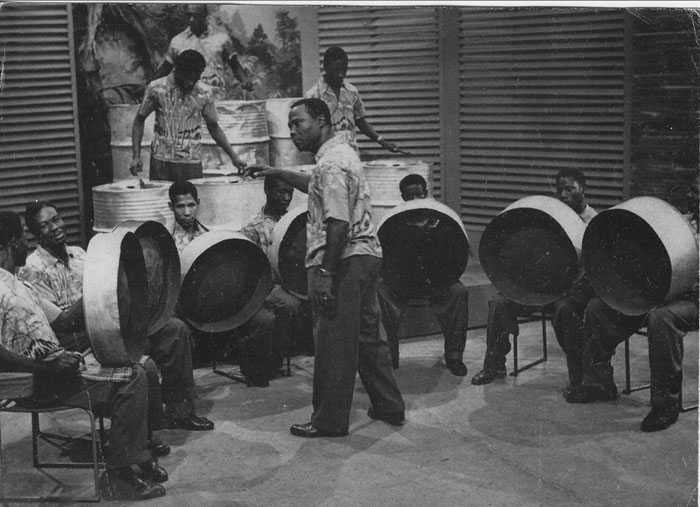
TASPO group in England, 1950, led by Lt. Nathaniel Griffith. Tony Williams is in the 2nd row, on the left . Courtesy Cyril Mathew and Anthony Williams
The early post-war scene for steel bands was a chaotic one. Members of different ad hoc groups, which included both musicians and supporters who filled in the numbers needed for an appropriate “posse,” might shift allegiances when it suited. One of these early bands came to be known as the North Stars. With time and some favorable public notice, a band could find some reasonably steady work at a local club. After a stint at an establishment, known as “The Waldorf,” popular with American servicemen, along with a personnel shake-up, the North Stars managed to snag the talents of Anthony Williams, which was a lucky break for them.
Tony Williams (familiarly known as “Skip”) had been to Britain with the TASPO organization. He was a carpenter by trade, but he had a great many other talents. Not only could he tune the steel pans, but even with his limited musical training he created an innovative “spider web” design for the “pans,” shaping the heads into a circle of fifths. He developed systems for supporting the pans so they could be played more flexibly, and even on the move.. Just as importantly, the other members of the North Stars recognized in him a quality of musical ability, leadership and organizational potential. He was a perfectionist, driven to make the North Stars a superlative musical phenomenon.
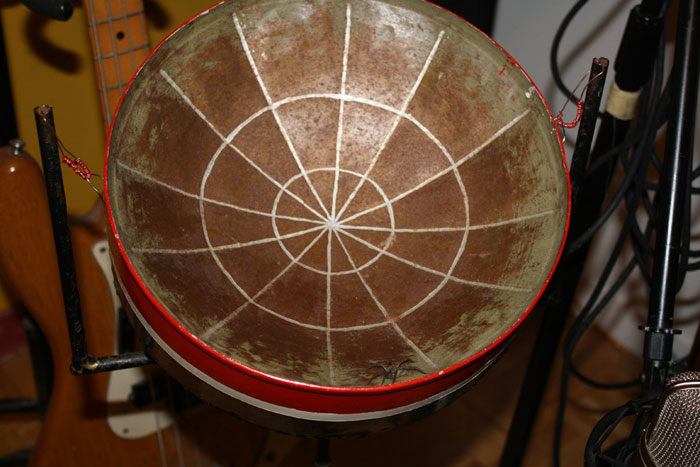
CAPTION: William’s innovative “spider web” design for the steel pan, Courtesy Cyril Matthew
“A MARRIAGE MADE IN HEAVEN”
In 1962, the band received top honors in a much-heralded steel band competition. This brought them to the attention of the local Pan Am manager David de la Rosa (a Trinidadian himself). An arrangement was made to have the North Stars Steel Band play as the "Pan Am North Stars". The band received a modest stipend in US dollars and in return they agreed to play twice a month and display the Pan Am logo.
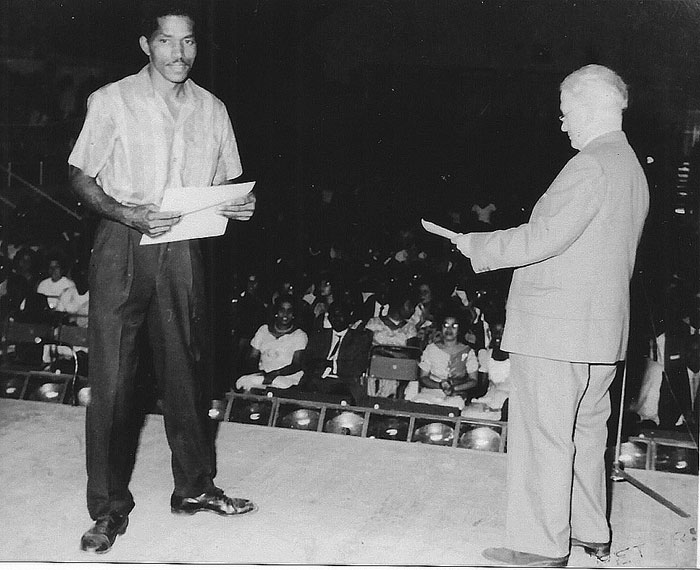
Anthony Williams receiving an award on behalf of the North Stars in 1962, Courtesy Cyril Matthew and Cecil Peters
Pan Am was no stranger to Trinidad. The airline had begun service to the island way back in 1929, when Charles Lindbergh flew the first mail delivery flight there on a Sikorsky S-38. The intervening years had seen the airline become an integral feature of Trinidad’s connections to the world.
As Cyril S. Matthew, author of “The Story of the Pan Am North Stars” (Layentille, Trinidad and Tobago, 2017) put it:
"Pan Am always took pride in providing the best service to its customers. The passengers on their flights were given top class service wherever they went with the airline. Pan Am was therefore regarded as the best in the business. North Stars had to live up to the standards of their sponsors. The joining of the airline with the best playing steelband therefore could be considered as a marriage made in heaven."
The Pan Am North Stars won the 1963 Panorama competition with their rendition of the Mighty Sparrow’s Dan is the Man (in the van)
Trouble viewing? Go to https://youtu.be/X7RBitSp-F4
Their first big job as a sponsored steel band came soon after when the airline inaugurated jet service to various islands across the Caribbean. The Pan Am North Stars, as they had now been re-branded, were invited to tour Pan Am’s island destinations to provide musical accompaniment to the events staged to welcome the new service. The tour occasioned a bit of a name modification too. David de la Rosa noticed that “Pan Am North Stars” was being abbreviated in newspaper accounts as “P.A.N.S.” and confused some readers as to the actual name of the band. So with a bit of marketing savvy, de la Rosa altered the band’s moniker to the “Pan Am JET North Stars.”
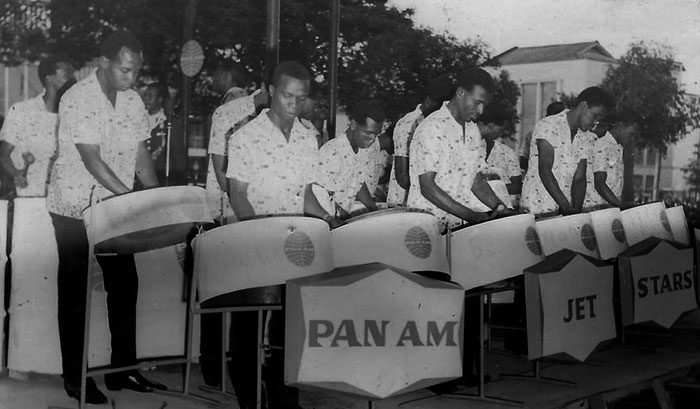
The Pan Am Jet North Stars on their first overseas tour, in the Caribbean. Courtesy Cyril Williams and Neville Gaskin
There were competing offers floated to the band to change their sponsorship affiliation. Some Trinidadians thought that a Trinidad band shouldn’t be sponsored by a foreign company. But the band’s leadership refused. Not only was Pan Am a worldwide, top-flight organization (literally!), it wasn’t overlooked that touring opportunities were likely to be much more robust with an airline as sponsor.
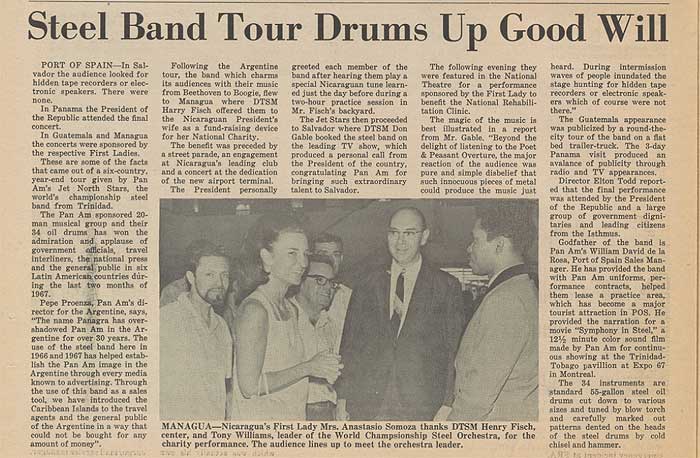
Story from the Pan Am Clipper March 1965 (University of Miami Special Collections).
HITTING THE TOP
Come 1964, the Pan Am Jet North Stars were really hitting their stride, although the year began slowly, with a trip by sea. Traveling to British Guiana (now Guyana), by ship, the musicians ran into a bit of unaccustomed difficulty. The ocean voyage left their pans coated with rust. Fortunately, that problem was easily overcome. Their trip to Puerto Rico later that year resulted in no such problems, as that one was made by Clipper!
But the close of the year provided their most spectacular opportunities to be introduced to new audiences far from home. In November, with great fanfare and the full backing of Pan American, the band traveled to New York to participate in a whirlwind of events. They played at Carnegie Hall, they played the Audubon Ballroom in Harlem, they performed in the Macy’s Thanksgiving Day Parade. And they were seen by a nationwide television audience of millions when they performed on the Ed Sullivan Show.
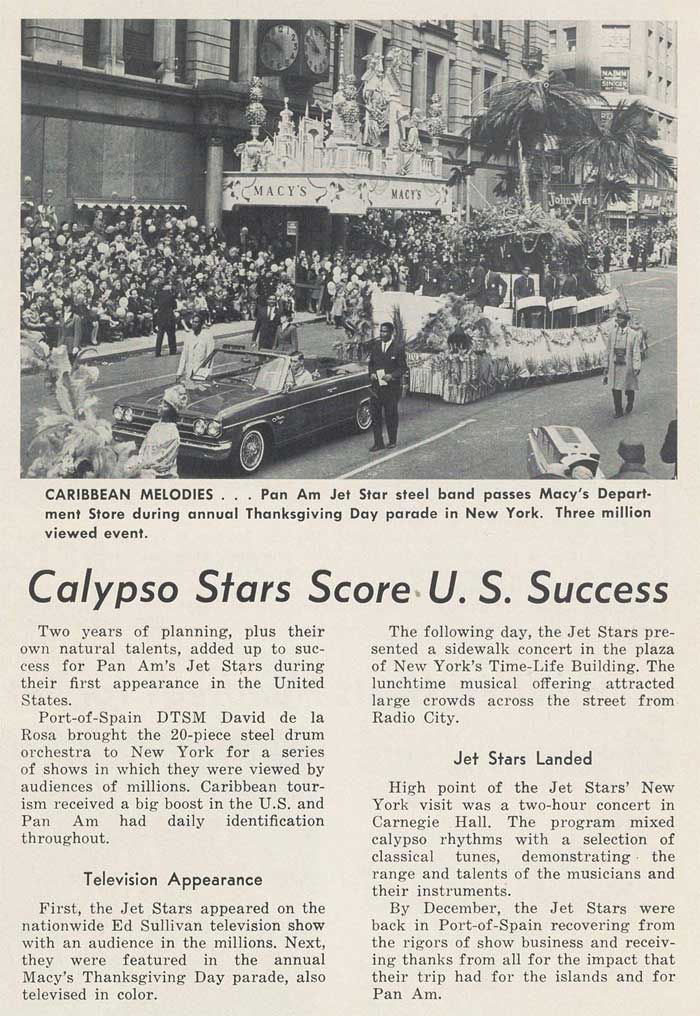
The Pan Am Jet North Stars in the 1964 Macy’s Thanksgiving Day Parade. They also appeared on the Ed Sullivan Show and gave a concert at Carnegie Hall.
Article from the Pan Am Clipper, January 1965, University of Miami Special Collections.
The years that followed provided plenty of opportunities for continued musical performance at home and abroad. There were trips to South and Central America, other Caribbean islands, and to the US where they headlined at Madison Square Garden, and even a national political convention.
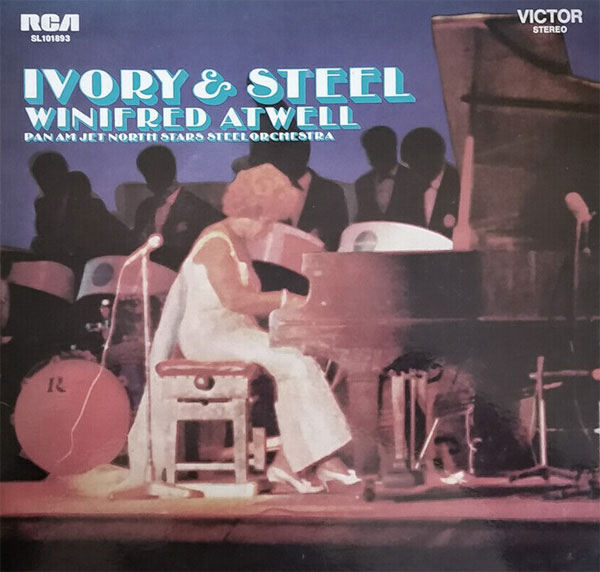
Ivory and Steel Album cover
IVORY AND STEEL
In 1969,, the Pan Am Jet North Stars teamed up with a classically trained Trinidadian pianist, Winifred Atwell, who had returned to Trinidad from Britain. The concerts they gave performing together were dubbed “Ivory and Steel.” Tony Williams had been steering the band towards a repertoire that included longer, classical pieces, including Grieg’s "Piano Concerto", "Claire de Lune", and "Rhapsody in Blue". These worked perfectly for the steel band and piano collaboration. “Ivory and Steel” was a smash hit.
George Gershwin’s "Rhapsody in Blue" performed by Winifred Atwell and the PanAm North Stars on “Ivory and Steel”
Trouble viewing? Go to https://www.youtube.com/watch?v=IXQDvxBLOQ4
Keeping the Pan Am Jet North Stars a going concern wasn’t easy. The band depended on members who weren’t all professional musicians. Some were students, or working people who had other jobs they needed to survive, and the situation required a lot of serious rehearsing. The sponsorship from Pan Am was certainly helpful, but it wasn’t enough to support the enterprise, if other factors were not working out.
The “Ivory and Steel” synthesis produced a unique sound, a blend of Old World classical musical tradition with something unique from the New World. It wasn’t lost on Tony Williams and others that it would be popular with audiences around the world, and so a multi-stop foreign tour was conceived. A contract was signed to finance the endeavor and the “Ivory and Steel” World Tour began in late October 1969. First stop: New York, where they were supposed to play multiple venues with Winifred Atwell, as well as make a recording.
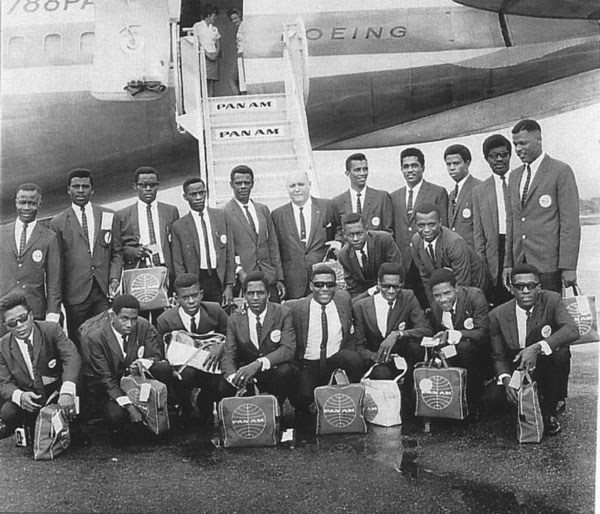
Off to an appearance in Brazil in 1969 by Pan American World Airways’ Jet Clipper. Courtesy Cyril Matthew and Winston Wellington
But the high expectations and excitement didn’t “pan” out. The local promoter in New York failed miserably to coordinate and manage the band’s accommodations, schedule, and local transportation. Even the final bus ride to bring the band back to JFK for their Pan Am Clipper trip home was late, so the Pan Am Jet North Stars flew back on a BWIA flight! They did manage to record the “Ivory and Steel” album before heading home. It’s a memorable sound you won’t find reproduced anywhere else. Fortunately you can find bits of the album online.
A GREAT RUN WHILE IT LASTED
After the disappointing tour, things seemed to go on a downward trajectory for the Pan Am Jet North Stars. There were a number of contributing factors.
The band, while often wildly-welcomed at performances, was not so warmly received by neighbors enduring their long outdoor practice sessions. As a result the band was often on the lookout for a more convenient place to perfect their repertoire, which demanded a lot of coordination and practice.
In April 1970, due to widespread social unrest mirroring that in other places around the world, Trinidad’s government imposed a curfew that lasted most of a year. That did great harm to the entertainment business. One result was the emigration of many Trinidadians to less-disrupted places. This included members of the band.
A 1971 tour to the UK proved a challange, which took a lot out of Tony Williams, who had been “Captain” of the North Stars since 1952. And so in August of 1972, Tony Williams let Pan American Airways know that he was giving notice that he was ending the sponsorship relationship.
Although the book was closed on the Pan Am Jet North Stars, Anthony Williams’ contributions to the music continued to be recognized. He received a series of laudatory awards, culminating in an honorary Doctor of Letters degree awarded to him by the University of the West Indies in 2016. Tony still lives in Trinidad, an elder statesman of the steel pan. And his technical and artistic contributions to Trinidad’s own musical art form survive, along with memories and some wonderful recordings that should stand the test of time, just like the legacy of their sponsor.
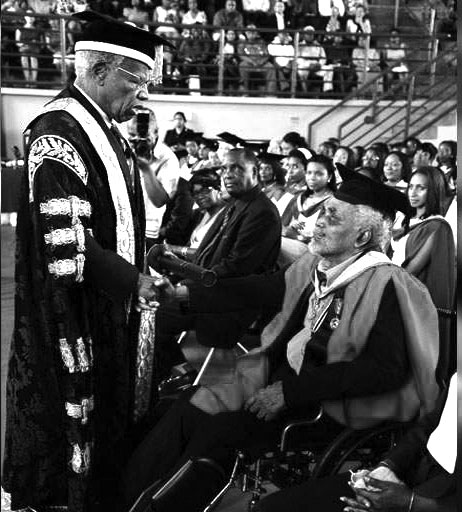
Anthory Williams’s contributions were recognized with an awarding of an honorary Doctor of Letters degree by the University of the West Indies in 2016. Courtesy Cyril Matthew and Anthony Williams
Thank You to Mr. Cyril S. Matthew, Author of the Book, “The Story Of Pan Am North Stars”
We are indebted for the help of Mr. Cyril S. Matthew, author of “The Story Of Pan Am North Stars” for his help in preparing this article. You can find out much more about Anthony Williams, Trinidad’s musical heritage, and the Pan Am North Stars Steelband in his book, “The Story of the Pan Am North Stars,”is available for purchase at https://www.amazon.com/Story-Pan-Am-North-Stars/dp/1729276776/
Here’s some colorful footage from Trinidad, provided by British Pathe showing Trinidad and Carnival in 1957. If you look closely, you’ll see a brief visual reference to Pan Am (not a plane!).
Trouble Viewing? Go to https://youtu.be/nC9OoXhHtug

